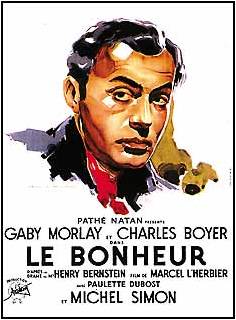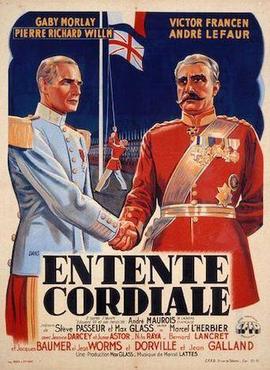
Montmartre is a large hill in Paris's northern 18th arrondissement. It is 130 m (430 ft) high and gives its name to the surrounding district, part of the Right Bank. Montmartre is primarily known for its artistic history, for the white-domed Basilica of the Sacré-Cœur on its summit, and as a nightclub district.
The Cemetery of Montmartre is a cemetery in the 18th arrondissement of Paris, France, that dates to the early 19th century. Officially known as the Cimetière du Nord, it is the third largest necropolis in Paris, after the Père Lachaise Cemetery and the Montparnasse Cemetery.

Jean Marie Lucien Pierre Anouilh was a French dramatist and screenwriter whose career spanned five decades. Though his work ranged from high drama to absurdist farce, Anouilh is best known for his 1944 play Antigone, an adaptation of Sophocles' classical drama, that was seen as an attack on Marshal Pétain's Vichy government. His plays are less experimental than those of his contemporaries, having clearly organized plot and eloquent dialogue. One of France's most prolific writers after World War II, much of Anouilh's work deals with themes of maintaining integrity in a world of moral compromise.

Marcel Marceau was a French mime artist and actor most famous for his stage persona, "Bip the Clown". He referred to mime as the "art of silence", performing professionally worldwide for more than 60 years.

Henri Alekan was a French cinematographer.
Joanna Marie Shimkus is a Canadian film actress. She is the widow of actor Sidney Poitier and mother of actress Sydney Tamiia Poitier.

Marcel L'Herbier was a French filmmaker who achieved prominence as an avant-garde theorist and imaginative practitioner with a series of silent films in the 1920s. His career as a director continued until the 1950s and he made more than 40 feature films in total. During the 1950s and 1960s, he worked on cultural programmes for French television. He also fulfilled many administrative roles in the French film industry, and he was the founder and the first President of the French film school Institut des hautes études cinématographiques (IDHEC).
Le Carnaval des vérités is a 1920 French silent film written and directed by Marcel L'Herbier.

Josette Day was a French film actress.

Michel Bouquet was a French stage and film actor. He appeared in more than 100 films from 1947 to 2020. He won the Best Actor European Film Award for Toto the Hero in 1991 and two Best Actor Césars for How I Killed My Father (2001) and The Last Mitterrand (2005). He also received the Molière Award for Best Actor for Les côtelettes in 1998, then again for Exit the King in 2005. In 2014, he was awarded the Honorary Molière for the sum of his career. He received the Grand Cross of the Legion of Honor in 2018.

El Dorado is a French silent film directed in 1921 by Marcel L'Herbier. The film was notable for integrating a number of technical innovations into its narrative of a "cinematic melodrama". It achieved considerable success on its release, as a ground-breaking film that was distinctively French at a time when the cinema was felt to be dominated by American productions.

L'Inhumaine is a 1924 French science fiction drama film directed by Marcel L'Herbier. It has the subtitle histoire féerique. L'Inhumaine is notable for its experimental techniques and for the collaboration of many leading practitioners in the decorative arts, architecture and music. The film caused controversy on its release.

The Virgin and the Gypsy is a 1970 British drama film directed by Christopher Miles and starring Joanna Shimkus and Franco Nero. The screenplay by Alan Plater was based on the novella of the same name by D. H. Lawrence. The film was voted "Best Film of the Year" by both the UK and USA critics.

Christopher Miles was a British film director, producer and screenwriter.

Le Bonheur ("Happiness") is a 1934 French comedy-drama film directed by Marcel L'Herbier. It was adapted from Henri Bernstein's play Le Bonheur, which Bernstein had staged in Paris in March 1933 with Charles Boyer and Michel Simon in leading roles; Boyer and Simon took the same parts in the film.

Up Jumped a Swagman is a 1965 British musical comedy film directed by Christopher Miles and starring Frank Ifield, Annette Andre, Ronald Radd and Suzy Kendall. It includes the songs "Waltzing Matilda" and "I Remember You".

Entente cordiale is a 1939 French drama film directed by Marcel L'Herbier and starring Gaby Morlay, Victor Francen and Pierre Richard-Willm. The film depicts events between the Fashoda crisis in 1898 and the 1904 signing of the Entente Cordiale creating an alliance between Britain and France and ending their historic rivalry. It was based on the book King Edward VII and His Times by André Maurois. It was made with an eye to its propaganda value, following the Munich Agreement of September 1938 and in anticipation of the outbreak of a Second World War which would test the bonds between Britain and France in a conflict with Nazi Germany.

Marguerite Moreno was a French stage and film actress.
Albert Rieux was a French stage and film actor.

Two Pennies Worth of Violets is a 1951 French drama film directed by Jean Anouilh and starring Dany Robin, Georges Baconnet and Madeleine Barbulée. It was one of two films directed by the dramatist Anouilh along with Traveling Light (1944). It was shot at the Billancourt Studios in Paris. The film's sets were designed by the art director Léon Barsacq.
















